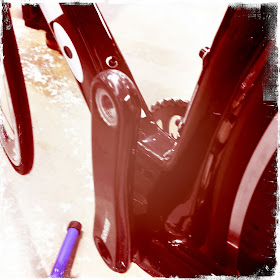 |
| Counter-steering... Photo by Lionel Bonaventure, Scanpix/AP |
Friday's stage from Pau to Lourdes was to me a gigantic one, bringing the very best of racing to the table. It brought back memories from the past, a glance of retro-racing, mano-o-mano, where the strongest wins. Of course, it helps that it was my fellow Norwegian Hushovd who pulled the longest straw in the end. Also the fact that he did it on a stage very few had anticipated while wearing the rainbow jersey, made it all almost romantic. What also is interesting is that this was one of the first times during this year's Tour, that the break went in. As Edward Pickering so brilliantly describes in his stage 13 analysis, today's break was always destined to succeed.
Descending is an art, just like climbing is. In 2009, the French newspaper L'Equipe, owned by the ASO, carried a poll where the riders in the peloton was asked who the best descender amongst them was. The winner turned out to be Thor Hushovd.
On the top of the majestic Col d'Aubisque, Hushovd had close to two minutes up to the the hard working Frenchman Roy, and a mere forty seconds to Moncoutie. Hushovd quickly rode in Moncoutie and when they got the bottom of the mountain, Roy had about fortifive seconds advantage, the rest is history.
Hushovd said to vg.no, a Norwegian newspaper, that he didn't take any chances. During the descend, his thoughts wandered to his daughter and he decided it wasn't worth it if he somehow gambled with his health. Instead he claimed he "didn't take any too large risks". Still, the numbers speak for themselves with Hushovd reaching 112 km/h (68 mph) as his top speed. Needless to say, when riding on a mere inch wide tires, that is special. The French cameraman who followed the descend on a moto filming the descend, said to French TV later that day that he'd never in his career witnessed a descend like that. Lionel Marie, DS in Garmin-Cervelo, said he was nervous in every bend, simply describing the performance as "fantastic".
 |
| Moncoutie hangs on to Hushovd's back wheel |
Well, what is it we can learn from Hushovd's descending? Hushovd's childhood is full of stories that might shed some light to his performance. First of all, he did a lot of cross-country skiing. This helps kids learn coordination, balance and is a very playful sport in the first place. Going down hills and mountains, earning sense of achievement, is vital for future development. He also learned to use a bike early, trying to copy his older brother. He played a lot on his bike, something which helped giving him balance on his bike. Hushovd's personal coach, Atle Kvålsvoll, said to vg.no that Hushovd played with high speed already in his youth. He has always liked speed and he even did motocross as a teenager, Kvålsvoll said, adding that Hushovd's technique is absolutely amazing. Hushovd himself emphasize the fact that his eyes are focusing a long distance down the road, not only on the meters just in font of the bike. This is vital for maintaining a line down the road that can support the highest speed possible. Although he reached 112 km/h, it is not the top speed that decides how fast you'll reach the finish, the average speed however, is what matters. By holding a line close to perfection, Hushovd was able to maintain a high speed everywhere on the road, which in the end gives a high average speed.
He also sports a large frame. Being about 82 kilograms, Hushovd is heavy compared to the majority of riders in the peloton. It helps during descends, if you're able to have a aerodynamic position on the bike while descending, something Hushovd don't seem to have any problems doing. He has a very aggressive style on the bike while descending.










